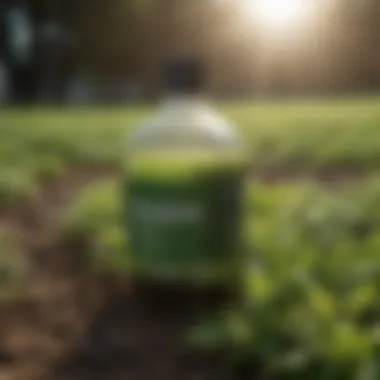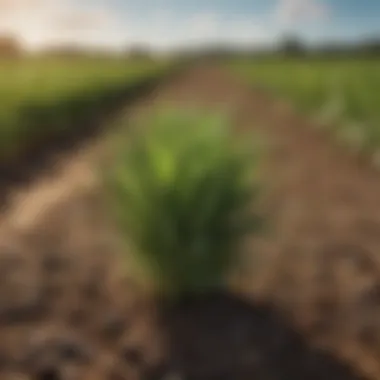Maxicrop Liquid Fertilizer: Benefits and Applications


Intro
In the quest for boosting agricultural productivity, fertilizers play a crucial role. Among the myriad of options available, Maxicrop liquid fertilizer stands out due to its unique formulation and proven effectiveness. This fertilizer is not just any run-of-the-mill product; it's derived from natural seaweed, boasting a rich nutrient profile that enhances plant growth and soil health.
Understanding how to leverage Maxicrop's properties means delving into its composition, the science behind its application, and its broader implications for sustainable farming practices. By the end of this analysis, farmers and agricultural enthusiasts alike will have a clearer perspective on how this fertilizer fits into their cultivation strategies, enabling them to make informed decisions.
Key Concepts and Terminology
To appreciate the advantages that Maxicrop liquid fertilizer offers, it's essential to familiarize oneself with certain concepts and terms within the realm of agricultural practices.
Definition of Terms
- Liquid Fertilizer: A type of fertilizer that is delivered in a liquid form, allowing for easier application and absorption by plants.
- Nutrients: Elements essential for plant growth, including nitrogen, phosphorus, and potassium, among others.
- Organic Matter: Decaying plant and animal material that enriches soil, enhancing its productivity and fertility.
Overview of Relevant Practices
Maxicrop fertilizer is often used in combination with several agricultural practices:
- Foliar Application: Spraying fertilizer directly onto plant leaves for quick absorption.
- Soil Drenching: Pouring the fertilizer around the base of the plants to improve root uptake.
- Composting: Mixing Maxicrop with organic materials to create nutrient-rich compost.
It’s important to understand how these practices maximize the benefits of Maxicrop, allowing for optimized growth across a variety of crops.
Current Trends and Innovations
The agricultural landscape continually evolves, with new research shedding light on fertilizer utilization and efficiency.
Latest Research and Developments
Recent studies indicate that eco-friendly options like Maxicrop can significantly reduce reliance on synthetic chemicals. Researchers are investigating the best application rates and timings, aiming to fine-tune its benefits as agricultural demands change.
Emerging Technologies and Tools
Farmers are increasingly turning to technology to enhance the efficacy of fertilizers. For example, drone technology is becoming prominent in delivering liquid fertilizers, allowing for precise application and minimizing waste. Such tools contribute to smarter agriculture, where resources are carefully managed.
Practical Applications
To ensure a successful experience with Maxicrop liquid fertilizer, understanding the practical applications is key.
Step-by-Step Guides
- Choosing the Right Type of Maxicrop: It's vital to select a variant that matches the specific crop needs. For instance, Maxicrop comes in different formulations, so understanding your crop’s nutrient requirements is crucial.
- Application Methods: Decide whether foliar or soil drenching is better suited for your situation. Both methods have their own advantages depending on crop type and growing conditions.
- Timing: Apply the fertilizer during critical growth stages, like early leaf development or flowering, for the best outcomes.
Troubleshooting Common Issues
While Maxicrop is effective, improper use can lead to issues:
- Over-Fertilization: Applying too much can result in nutrient burn; sticking to recommended dosages is essential.
- Timing Misalignment: Misapplication during dormancy can waste the fertilizer's potential.
Important Note: Always consider soil testing before application to ensure that Maxicrop meets the specific requirements of your crops.
As we move further into this analysis, we will delve deeper into the benefits and scientific insights that make Maxicrop a staple in sustainable farming practices.
Prelude to Liquid Fertilizers
In the realm of agriculture, liquid fertilizers have emerged as essential tools for enhancing crop productivity. Their unique formulation allows for quick absorption by plants, facilitating more immediate benefits compared to traditional granulated fertilization methods. With the rising demands for efficient food production spurred by a growing global population, understanding liquid fertilizers’ role is more critical than ever. This article aims to explore this subject, focusing on Maxicrop liquid fertilizer as a prime example.
Liquid fertilizers differ fundamentally from their solid counterparts. They are composed of a concentrated mix of nutrients dissolved in water, which allows for faster nutrient availability when introduced to the soil or applied directly to plants. The way these fertilizers interact with the soil and plants underscores their significance in sustainable agriculture.
Moreover, the advantages of liquid fertilizers extend beyond mere nutrient delivery. They can effectively combat soil compaction and improve overall soil structure. With their ability to penetrate the soil more effectively, they also contribute to increased microbial activity, fostering conditions favorable for plant growth. Exploring these aspects gives insight into why liquid fertilizers, especially those formulated like Maxicrop, have gained popularity.
"Liquid fertilizers can substantially enhance the efficacy of nutrient delivery, making them a favorite among modern agricultural practices."
Understanding Fertilization in Agriculture


Understanding fertilization is key to successful agriculture. Fertilizers are substances that supply essential nutrients to plants, which are necessary for their growth, development, and overall health. Plants require three primary macronutrients: nitrogen, phosphorus, and potassium — often abbreviated as NPK. Each of these plays a unique role in the growth cycle. For instance, nitrogen is crucial for leaf development, phosphorus supports root and flower growth, and potassium enhances resilience against diseases.
In addition to the macronutrients, plants also need micronutrients like iron, manganese, and zinc. These elements, although required in smaller quantities, play vital roles in processes like photosynthesis and nutrient uptake. A well-balanced fertilization plan takes into account all these elements, ensuring plants receive the right amount at the right time.
With the growing emphasis on sustainable agriculture, understanding the interplay between soil fertility and crop health becomes even more significant. Soil's complex ecosystem hosts a variety of microorganisms that assist in nutrient cycling. Hence, utilizing fertilizers that not only supply these nutrients but also stimulate soil health is invaluable.
The Role of Liquid Fertilizers
The role of liquid fertilizers in agriculture cannot be overstated. They serve numerous purposes that contribute to both better crop yields and healthier soils. Firstly, their liquid form allows for easy mixing with water, making them convenient for farmers. Liquid fertilizers can be quickly applied through various methods, such as foliar feeding or drip irrigation, ensuring that nutrients reach plants effectively.
Their rapid absorption is another critical factor. Once applied, nutrients from liquid fertilizers can be taken up by plant roots almost immediately. This responsiveness is particularly beneficial during critical growth phases, such as flowering and fruiting when plants require more nutrients to support their development.
Furthermore, liquid fertilizers can be tailored to meet specific crop needs, providing a precise nutrient profile. They can be blended to address deficiencies identified through soil testing, allowing for targeted interventions and optimal plant nutrition.
In summary, liquid fertilizers are not only essential for maximizing crop yield but also play a role in promoting better soil dynamics. With advancements in formulations like Maxicrop liquid fertilizer, farmers can harness the efficiency and effectiveness of these products, enhancing both agronomic practices and ecological health.
What is Maxicrop Liquid Fertilizer?
Understanding what Maxicrop liquid fertilizer is, along with its essential attributes, is crucial for farmers and gardening enthusiasts alike. This fertilizer, primarily derived from seaweed extracts, caters to the need for enriching soil and enhancing plant growth. The focus on Maxicrop lies not just in its application but also in its unique composition, which assures better nutrient absorption by plants. Grasping how this product works enables users to optimize yield and promote healthier crops, aligning with sustainable agricultural practices.
Composition and Nutrient Profile
Maxicrop liquid fertilizer comprises a rich blend of natural ingredients. The principal component is extracted from Ascophyllum nodosum, a species of brown seaweed known for its high concentration of essential nutrients. This specific type of seaweed flourishes in nutrient-rich marine environments, which allows it to accumulate numerous beneficial compounds.
The nutrient profile is remarkably diverse and includes:
- Nitrogen (N): Vital for plant growth, especially in the vegetative stages. Nitrogen promotes healthy foliage and overall vigor.
- Phosphorus (P): Essential for root development and flowering. Phosphorus is particularly important in helping plants establish themselves.
- Potassium (K): Increases resistance to stress, improving plant health during drought or frost conditions.
- Trace elements: Includes micronutrients such as iron, manganese, and zinc, which support various physiological functions in plants.
The balanced mix of these nutrients ultimately leads to improved plant metabolism and growth, paving the way for more robust harvests. This formulation, especially when derived from natural sources, tends to be gentle on the environment, putting it ahead in the holistic agricultural sphere.
Types of Maxicrop Products Available
Maxicrop offers a variety of products tailored for different applications, to cater to the needs of diverse agricultural practices. Here are some notable variants:
- Maxicrop Liquid Seaweed: This is the flagship product, used widely for all kinds of plants. It serves as a growth enhancer and works effectively in promoting root and shoot development.
- Maxicrop for Flowers: Created specifically to encourage blooming, this variant is enriched to maximize flowering potential, an ideal choice for florists and gardeners focused on aesthetics.
- Maxicrop for Vegetables: Aimed at vegetable growers, this formulation helps increase nutrient density while improving flavor and overall quality.
- Maxicrop Garden Care: This multi-purpose solution targets residential gardeners, focusing on maintaining healthy lawns and ornamental plants.
By providing distinct formulations, Maxicrop allows agricultural practitioners to choose a product that closely aligns with their specific growing conditions and crop types.
"The proper use of fertilizers can distinguish between a mediocre harvest and a bountiful one. Maxicrop serves not only as a nutrient source but also fosters a stronger connection between farmer and land."
In summary, knowing what Maxicrop liquid fertilizer entails and exploring its various forms is key for anyone serious about enhancing their crops. Its impressive array of nutrients and tailored applications positions it as a favored selection in many farming communities.
Benefits of Using Maxicrop Liquid Fertilizer
Maxicrop liquid fertilizer offers a multifaceted approach to boosting agricultural productivity, making it a valuable tool for farmers and gardening enthusiasts alike. The diverse benefits it presents are grounded in its ability to enhance soil health, promote vigorous plant growth, and foster sustainable farming methods. As we delve into each of these areas, it becomes apparent just how central liquid fertilizers can be in modern farming practices. Here’s a closer look into the notable advantages offered by Maxicrop.
Enhancing Soil Health
Soil health is foundational to successful farming, acting as the bedrock for plant growth and productivity. Maxicrop liquid fertilizer contributes significantly to this critical aspect by enriching the soil with essential nutrients and organic matter. In particular, its high potassium and magnesium content aids in structuring soil, which improves water retention and drainage.
Regular application of Maxicrop can invigorate microbial life in the soil, leading to enhanced nutrient cycling. According to research, the availability of nutrients, especially nitrogen, phosphorus, and potassium, drastically increases when liquid fertilizers are properly used. This not only helps to replenish depleted soils but also promotes a healthier ecosystem underground, vital for sustainable agriculture.
"Healthy soil leads to healthy plants, ultimately resulting in a better yield for farmers."
In addition to fostering better microbial activities, Maxicrop also helps in reducing soil compaction. By improving aeration and water infiltration, it sets the stage for increased root growth, paving the way for robust plant development.
Improving Plant Growth and Yield
Maxicrop liquid fertilizer is heralded for its effectiveness in enhancing plant growth and increasing yields. This liquid formulation allows for rapid nutrient uptake, meaning your crops can access essential elements without delay. As a result, plants treated with Maxicrop tend to show green leaves, strong stems, and a noticeable increase in overall vigor.
The unique blend of nutrients in Maxicrop targets various growth stages, making it suitable for both young seedlings and mature plants. For instance, high phosphorus levels can stimulate root development in the early stages, while potassium helps strengthen plants against diseases and stress during later stages.
Farmers have reported yields that are significantly higher—often by 15-20%—compared to those using traditional granular fertilizers. This advantage is crucial as it translates into better profitability without requiring more land or significantly increasing input costs.


Promoting Sustainable Agricultural Practices
In this age of environmental awareness, sustainable farming practices are more than just a trend; they are a necessity. Maxicrop aligns well with these practices by supporting organic farming standards with its natural composition. The fertilizer's organic origins and low chemical content make it an attractive choice for eco-conscious farmers who wish to minimize their ecological footprint.
Using liquid fertilizers can also lead to reduced soil erosion and less runoff, as they are typically absorbed more quickly than traditional fertilizers. This means that there’s less likelihood of nutrient loss to waterways, supporting better water quality and protecting local ecosystems.
Supporting sustainable agriculture also means encouraging biological diversity. Maxicrop’s enhancements in soil health naturally attract a variety of beneficial insects and organisms that play critical roles in maintaining ecosystem balance. Farmers, therefore, don’t just increase productivity; they also contribute positively to the environment.
In summary, Maxicrop liquid fertilizer stands as a powerful ally to farmers aiming to improve soil health, boost plant growth, and adopt sustainable farming practices. Each application leads to a wealth of opportunities for enhanced agricultural output and environmental care.
Application Techniques for Maxicrop
When it comes to getting the best out of Maxicrop liquid fertilizer, knowing how to apply it makes all the difference. The right application techniques can boost crop yield and improve soil health significantly. It's critical to take time understanding these methods, as they can help farmers and horticulturists optimize their fertilization strategies and ensure that crops get the most benefit from Maxicrop.
Mixing and Dilution Guidelines
Getting the mix right can be a bit like cooking – too much of one ingredient can ruin the whole dish. For Maxicrop, the general rule is to follow the instructions on the product label closely. Most formulations suggest a dilution ratio that balances efficiency and effectiveness.
- For instance, a common dilution might involve mixing Maxicrop with water at a ratio of 1:10 or 1:20, depending on the type of crop being treated.
- Always mix it in a clean container to avoid contamination. It's worth noting that the water quality can also affect outcomes; rainwater is usually ideal, as it's free of chemicals found in tap water.
Keep in mind that over-diluting can lead to reduced nutrient uptake by plants. Meanwhile, under-diluting can burn plant leaves or negatively impact soil health. So hitting that sweet spot is essential for optimal growth.
Timing of Application
Timing is everything in agriculture. Applying Maxicrop at the correct growth stage can significantly impact how effectively it helps your crops.
- Early Stages: For many crops, applying Maxicrop when they are just emerging helps establish strong roots.
- Vegetative Growth: As plants transition into this phase, a booster application can highly enhance leaf and stem development.
- Flowering and Fruiting Stages: This is a critical period; a well-timed application here can lead to more fruits and healthier flowers.
"Timing not only matters, it can make the difference between a bumper crop and a failed harvest."
Moreover, environmental conditions should also be considered. Applying fertilizer just before a rain continues to be a savvy practice, as it ensures the nutrients are washed into the soil where they’re needed. However, avoid applying during extreme heat or drought conditions when plants are stressed, as they may not absorb nutrients effectively.
Methods of Application: Foliar vs. Soil
Choosing between foliar and soil application methods is a topic deserving close attention. Each method has its pros and cons, and the best choice often depends on specific farming conditions and the crop species.
- Foliar Application:
- Soil Application:
- This method involves spraying the mixture directly onto the leaves.
- It allows for rapid uptake of nutrients, which can be beneficial in situations where immediate action is needed, such as when plants show signs of deficiency.
- Always do this either early in the morning or late in the evening to avoid sun scorching the foliage.
- This involves applying the fertilizer to the soil, allowing nutrients to enter through the root zone.
- It's particularly effective for long-term conditioning, as it enriches the entire soil ecosystem.
- However, soil applications may take longer for plants to benefit from the nutrients compared to foliar applications.
Maxicrop in Different Agricultural Contexts
Understanding how Maxicrop liquid fertilizer functions in various agricultural settings can be a game-changer for farmers and enthusiasts alike. It's not just about applying nutrients; it's about optimizing those nutrients for specific crops and conditions, enhancing not just yield, but the quality of produce. This section delves into the tailored usages of Maxicrop in multiple agricultural contexts, exploring its vast potential and benefits.
Use in Horticulture
Horticulture often demands precise nutrient management to ensure high-quality fruits, vegetables, and ornamental plants. Maxicrop's composition, rich in algae extracts and essential elements, supports enhanced growth responses when applied correctly. For instance, the liquid format allows for quick absorption, which is a boon for delicate plants that might struggle with solid fertilizers.
- Nutrient Availability: Since horticultural crops are typically grown in smaller areas with more confined root zones, the liquid nature of Maxicrop ensures immediate nutrient uptake, giving what plants need without delay.
- Improved Flavor and Quality: Many users report that fruits treated with Maxicrop have superior taste and texture. The trace minerals in the formula can result in healthier plant development, creating vibrant colors and stronger flavors.
- Flexibility in Application: Whether it's a quick foliar application or soil drenching, Maxicrop's versatility fits nicely into varying horticultural practices. This means gardeners can choose methods based on their specific crop type and timing needs.
Application in Organic Farming
In organic farming, maintaining the ecological balance is crucial. Maxicrop fits seamlessly within this agricultural philosophy, offering a natural solution to replenishing soil nutrients. Utilizing this product can support the organic certifiers' guidelines while promoting plant health in a sustainable manner.
- Organic Certification Compatibility: Utilizing seaweed extract as a fertilizer aligns with organic farming principles, making it an attractive option for farmers looking to maintain or achieve certification.
- Soil Health Enhancement: Regular application can stimulate microbial activity in the soil, further enriching the nutrient profile and supporting the entire ecosystem embedded within the farming practice.
- Pest and Disease Resistance: Plants that receive proper nutrition from Maxicrop often exhibit increased resilience against pests and diseases, an essential factor in organic farming's preventive approach.
Maxicrop for Indoor Plants
Indoor gardeners often grapple with nutrient management due to the confined environment and varying light conditions. Maxicrop offers a solution that ensures indoor plants receive the nutrients they require, adapting easily to these challenging conditions.
- Convenience and Ease of Use: Indoor applications are simple; a little goes a long way. The liquid fertilizer can be diluted in water and used during regular watering, providing a straightforward method for providing essential nutrients.
- Nutrient Balance for Different Plants: From flowering houseplants to leafy greens, Maxicrop’s diverse nutrient profile caters to a wide variety of indoor species, ensuring each plant’s unique needs can be met efficiently.
- Healthier Growth: Users often observe a noticeable difference in plant vigor and leaf health after incorporating Maxicrop. This boost in health can lead to more prolific blooming in flowering plants and lush growth in leafy varieties.


Maxicrop's adaptability in different settings not only enhances the agricultural experience but assures users of sustainable growth practices suitable for their specific environments.
By examining Maxicrop's diverse applications in horticulture, organic farming, and indoor gardening, one can appreciate the nuanced benefits of this liquid fertilizer. The tailored strategies for each context help foster healthier plants and more productive yields.
Scientific Research and Studies on Maxicrop
Research surrounding Maxicrop liquid fertilizer has become increasingly significant for understanding its effectiveness and implications in diverse agricultural settings. Scientific studies serve as a backbone for both validating claims made by manufacturers and ensuring that farmers can make informed decisions based on data. The goal here is to paint a clear picture of how Maxicrop compares to traditional fertilizers and its influence on soil health.
Crop Performance Compared to Traditional Fertilizers
Research shows that the performance of crops using Maxicrop can often surpass that of crops treated with conventional fertilizers. It starts with the composition of Maxicrop, which includes seaweed extracts known for their rich nutrient profile. This formulation can lead to healthier plant growth, ultimately resulting in better yields. Studies have indicated that crops such as tomatoes and cucumbers see an improvement in growth rates when treated with Maxicrop compared to standard fertilizers.
- Higher Nutrient Uptake: One key finding is that plants using Maxicrop demonstrate a better nutrient uptake. This advantage occurs because the liquid form allows nutrients to be more readily absorbed by plants.
- Enhanced Quality: Researchers have also noted that crops nurtured with Maxicrop not only thrive in terms of growth, but tend to show improvements in quality, color, and taste. These factors can ultimately influence market prices favorably.
Utilizing data from agricultural experiments, researchers continually assess the impact of liquid fertilizers like Maxicrop. The consistent findings suggest a trend: Maxicrop liquid fertilizer not only competes with traditional fertilizers but often outshines them, especially in organic and sustainable practices.
Soil Microbial Activity and Health
Another crucial aspect of the scientific research conducted on Maxicrop is its role in enhancing soil microbial activity and overall soil health. Microorganisms in the soil are vital not only for nutrient cycling but also for maintaining ecological balance.
- Stimulates Beneficial Microbes: The natural ingredients in Maxicrop can stimulate populations of beneficial soil microbes, leading to improved soil structure and health.
- Resilience to Stressors: When soil microbiomes are robust, they enhance the resilience of the soil to pests and diseases. This improved health not only supports higher crop yields but helps in maintaining long-term agricultural productivity.
"The health of soil is not just important for the current crop but serves as a foundation for future harvests."
Trying to understand how Maxicrop impacts microbial dynamics helps farmers see the broader implications of their fertilization choices. Long-term studies indicate that adopting Maxicrop can lead to a sustainable improvement in soil quality.
Potential Drawbacks and Considerations
In the journey of optimizing agricultural practices with Maxicrop liquid fertilizer, it's essential to cast a discerning eye on not just its myriad benefits, but also the potential drawbacks and considerations that may arise. Understanding these aspects ensures that farmers and agricultural enthusiasts make informed choices, thereby maximizing efficiency while minimizing adverse effects.
Environmental Impact
While liquid fertilizers like Maxicrop offer numerous advantages, they aren't without their environmental concerns.
- Nutrient Runoff: One major issue is the possibility of nutrient runoff during heavy rains. This can lead to the contamination of nearby water bodies, promoting algal blooms which deplete oxygen levels, ultimately harming aquatic life.
- Soil Health: Continuous use of liquid fertilizers may alter soil microbial communities, impacting their ability to sustain plant health. Over-dependence can lead to nutrient imbalances or depletion of crucial elements, affecting long-term soil fertility.
- Bioaccumulation: The buildup of certain nutrients, like nitrogen and phosphorus, can cause toxicity in certain soils if not managed properly. Producers need to monitor these nutrient levels to avoid negative consequences.
"The key is sustainable application—ensuring that what is added to the soil will contribute positively without leading to depletion or environmental harm."
Cost Analysis for Farmers
Examining the cost implications of Maxicrop is crucial for those in the farming community. While the upfront investment might seem reasonable, understanding the total cost of ownership provides greater clarity.
- Initial Investment: Liquid fertilizers can sometimes be more expensive per liter compared to granular alternatives. This price point can be a hurdle for small-scale farmers trying to maintain profit margins.
- Application Costs: The equipment required for efficient application of liquid fertilizer must be considered. Farmers might have to invest in sprayers or mixing equipment, not to mention the labor costs associated with their usage.
- Long-term Return on Investment: It’s worth analyzing the yield gains against the costs incurred. If Maxicrop markedly boosts crop performance, the higher initial investment could be justified in the long run.
Ending: The Future of Liquid Fertilizers
As we step into an era where environmental concerns loom larger, the significance of liquid fertilizers like Maxicrop becomes increasingly apparent. These fertilizing solutions are not just about enhancing crop yields; they represent a shift towards sustainable agricultural practices that can feed a growing population while caring for our planet. The future of liquid fertilizers is inextricably linked to innovations that prioritize both efficiency and ecological balance.
Trends in Sustainable Farming
Many farmers are now leaning towards sustainable farming practices, seeing them not just as a trend but a necessity. With climate change affecting weather patterns, it’s crucial to adapt farming techniques that conserve resources and reduce environmental footprints. Liquid fertilizers are adept at meeting these needs by allowing for precise nutrient delivery, minimizing waste.
Some notable trends include:
- Integrated Nutrient Management: Combining organic matter with liquid fertilizers to fortify the soil's nutrient bank.
- Precision Agriculture: Utilizing data-driven methods to apply fertilizers at the right time and place, hence reducing excess.
- Organic Certification: More liquid fertilizers are becoming organic-friendly, appealing to a niche market demanding eco-conscious options.
These practices highlight an essential learning curve in agricultural methods, where the focus shifts from merely maximizing output to a holistic approach embracing long-term environmental stewardship.
Maxicrop’s Place in the Market
Maxicrop stands at a crucial intersection in the fertilizer market, offering solutions that align with the principles of sustainability. Its unique formulation enables farmers to enhance soil fertility while mitigating potential negative impacts on the environment. The competitive market demands continuous improvement, and Maxicrop's commitment to research and development keeps it relevant.
The demand for liquid fertilizers is on the rise, influenced by several factors:
- Growth in Organic Farming: As organic produce gains popularity, Maxicrop's products cater well to this sector, boasting organic attributes.
- Increasing Knowledge among Farmers: More agriculturalists are educated on soil health and the role of fertilizers, pushing for superior products.
- Market Adaptability: Maxicrop actively re-evaluates its positioning based on feedback, ensuring it provides solutions that meet the shifting preferences of modern-day farmers.
These dynamics position Maxicrop favorably for the future as agriculture evolves. The inclusion of scientific insights and sustainable practices will determine how the market shapes up, and Maxicrop is poised to lead this change.
"The future of farming is in the hands of those who understand and innovate, turning challenges into opportunities."
In summary, liquid fertilizers, especially Maxicrop, are more than products; they are components of a sustainable future. The key will be to stay informed, adaptive, and committed to practices that foster both agricultural productivity and environmental health.







